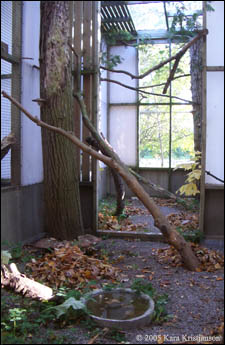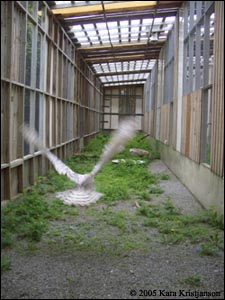| 40 Complex - Release Training | |
|
| 40 Complex offers areas for the release training of both small and large-sized owls. Originally it also doubled as The Owl Foundation's Burrowing Owl breeding facility. With the termination of this project, we have converted four of the Burrowing Owl units (complete with artificial burrows) into a 1120 sq. ft. unit for some of our non-releasable Short-eared Owls. | ||
 |
||
|
Small Owls: Six individual 20' x 10' x 15' units and one 20' x 14' x 15' unit with interconnecting gates are utilized for release training of small owls such as Eastern Screech, Northern Saw-whet and Boreal Owls. These units are equipped with two to four roost boxes, pools for bathing, a variety of multilevel perching and natural growing ground cover. Each cage incorporates slatwork, 1' wire and fibreglass sheeting to provide both access and protection from the elements. Unfortunately, vegetation begins to die off as winter approaches. In order to continue training on warm autumn days, staff put piles of fallen leaves into these units so prey can still hide and so owls are still forced to use their sense of hearing (as seen to right). No more than two owls of the same species are ever placed concurrently in one unit. This is to ensure a minimum of territoriality, competition and overall stress (all of which can lead to death) and a maximum learning curve. |
 |
|
| |
||
|
Large Owls: Two 84' x 10' units make up the bulk of 40 complex. Both incorporate the same alternating framework of wire, slats and fibreglass to provide sheltered areas and open ones. High perching is only provided at either end of the 84' length, forcing occupants to fly long distances. This builds stamina and thereby prepares owls for long distance flying. Ground cover provides live prey (mice, rats and quail) with shelter and makes owls utilize both their keen senses of sight and hearing to locate and pursue this prey. There are also stumps and low branches that owls can use during hunting, or sunning after a bath. Each of these cages can hold maximum capacity of six owls, depending on species, age, sex and time of year. Sometimes territorial adult owls, for instance, will not accept cagemates. Foster siblings, on the other hand, will often relate with minimal stress. Kestrels: The Owl Foundation inevitably receives over a dozen Kestrels each year. Once ready for release training, these birds require a lot of space to practice flying, manouvering and hunting. In order to accomodate these small falcons, we have converted one of the interior corridors of 40 Complex into a Kestrel Flight. This unit is 84' long by 4' wide. It is approximately 18' high. |
 A Snowy Owl (Nyctea scandiaca) flies the full 84' length of its training unit. It is important to keep the flight path unobstructed as owls arc between perches; often catching prey on the wing. |
|